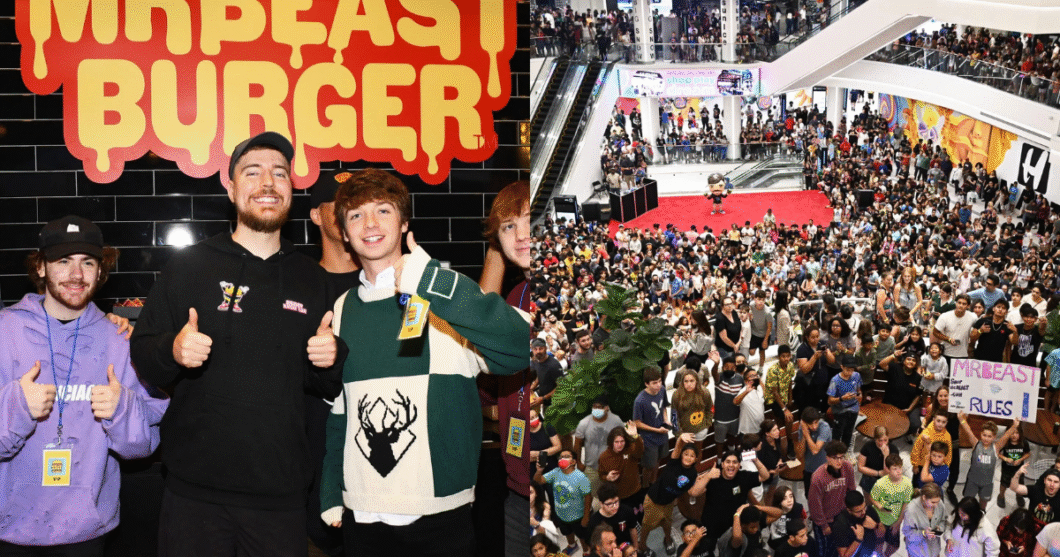The Shift We’re Living Through
“Attention is the new currency — but attention alone no longer pays the bills.”
That’s the paradox of our era. In 2025, every scroll, click, and like is a micro-transaction in culture — yet the creators who command that attention are no longer content to stay behind screens. They’re evolving into founders, curators, and architects of Creator-Led Experiences — transforming digital influence into physical spaces people can touch, taste, and belong to.
The future of business is being built at the intersection of content and community, where storytelling doesn’t end on social media — it continues in cafés, events, pop-ups, and products that turn audiences into participants.
A Global Tide Is Turning
We are witnessing a seismic shift in how influence becomes value:
- Take Nothing’s collaboration with MrWhoseTheBoss — rather than a mere sponsorship, the brand co-designed a dream phone with the YouTuber, turning audience ambition into product speculation. Android Authority
- Or look at MKBHD, who has long influenced gadget culture through reviews — now shaping the very outlines of hardware with his voice and credibility.
- And then there’s MrBeast, who scaled from viral videos to launching food chains, merch, and immersive event experiences. His empire doesn’t just entertain — it inhabits real spaces and lives.
These aren’t anomalies. They’re harbingers. Global creators are rewriting the playbook: content is the invitation, but the experience is the destination.
Why Now? Because the Ecosystem Changed
- The global creator economy alone is accelerating: some forecasts project it reaching $480 billion by 2027. Forbes
- More than 207 million people now identify as creators worldwide — a testament to the scale of this shift. InBeat+1
- Meanwhile, marketing budgets are redirecting toward creator-led platforms — WPP forecasts suggest that in 2025, creator platforms may generate more ad revenue than traditional media. Business Insider
- Full-time creator roles in the U.S. have exploded — rising from 200,000 in 2020 to 1.5 million in 2024 — a 7.5× growth. Axios
In other words, the infrastructure has matured: tools, platforms, trust, and capital are bending in favor of creators.
We’ve Entered the Era of Creator-Led Experiences
Digital influence is now the seed — and what’s sprouting are physical manifestations of brand worlds. We’re past the phase where creators simply monetize content. Now they’re building immersive experiences — cafés, tours, flagship products, live events — where every touchpoint feels like a chapter of their story.
In this era, the question is no longer “How do I get attention?” but “How do I translate attention into worlds people want to live in?”
In this article, we’ll journey from global titans who are already doing this to Caribbean creators who are trailblazing real-world proof points. You’ll see how digital trust becomes bricks, tastes, chairs, and moments. And we’ll dissect exactly how to build your own experience-led brand in this new age.
My Own Taste of the Creator-Led Experience
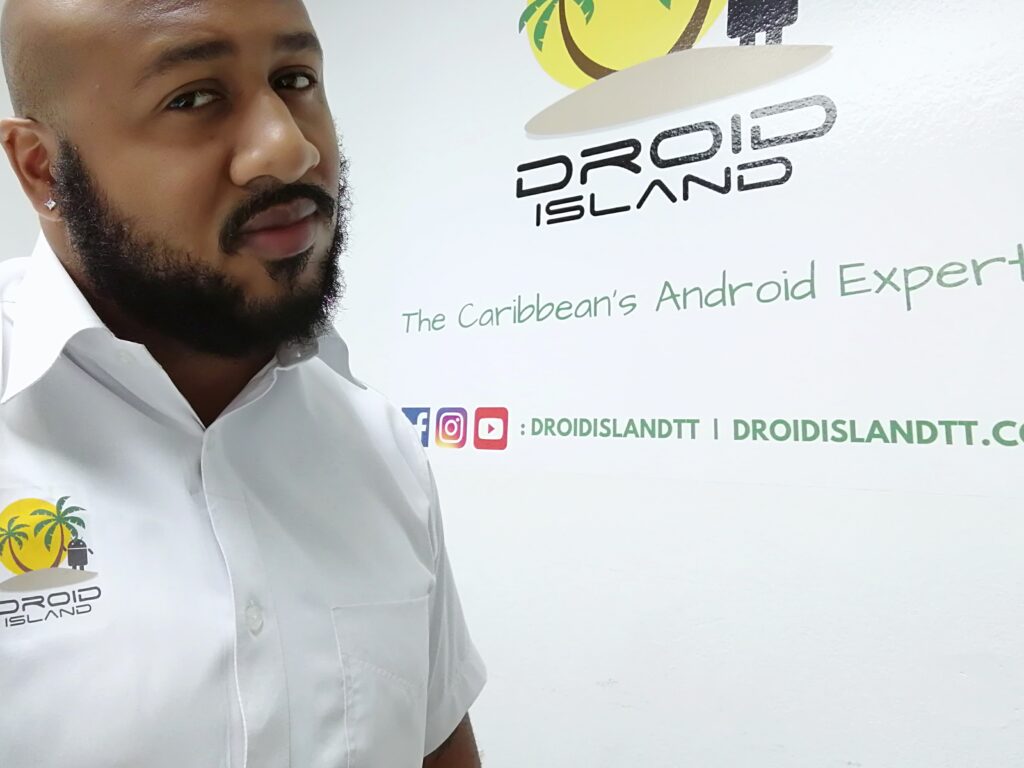
Before I understood what Creator-Led Experiences truly meant, I was living it.
Back in 2016, I started as a simple tech blogger — writing about smartphones, apps, and digital tools. Over time, those articles built an audience that trusted my recommendations and came to me for advice on what to buy and how to use technology to stay connected.
That trust eventually led me to open The Droid Island Store — a physical retail space born entirely out of my digital content. My articles, YouTube videos, workshops, and radio segments didn’t just build awareness — they drove real foot traffic to the store.
People weren’t coming in because of ads. They were coming in because they already knew me, my story, and my expertise. That’s when it clicked:
My content had built a relationship, and that relationship had built a business.
Running the store also forced me to learn the next evolution of commerce — E-Commerce. I wanted customers to be able to purchase online, learn through digital content, and connect beyond Trinidad. That led me deeper into the world of digital payments, logistics, automation, and monetization, which eventually became the foundation of everything I teach today.
So when I talk about Creator-Led Experiences, I’m not speaking as an observer — I’m speaking from experience. I’ve lived that transition from content to commerce, from clicks to customers, and from community to company.
And now, we’re seeing a new generation of Caribbean creators doing the same — each in their own unique way.
II. The Global Transformation: Why This Is Happening Now
The world is not just shifting — it’s mutating. The foundations of how value is created, captured, and shared are being retooled in real time. What used to work — billboards, mass media, broad-scale advertising — is losing its potency. In its place, a new economy is emerging: one built on attention, trust, community, and experiences.
Below is the scaffolding for how we got here.
1. The Creator Economy Explosion
In just a few short years, the “creator economy” has evolved from a fringe concept into a multi-hundred–billion-dollar industry.
- $480 billion by 2027
Goldman Sachs estimates that the total addressable market of the creator economy could nearly double to $480 billion by 2027 (from ~$250 billion today). Goldman Sachs - From 50 million creators to professionals
Today, an estimated 50 million people globally identify as creators; only a fraction—around 4 %—earn over $100,000 annually through their work. Goldman Sachs - Brands shifting investment
The narrative is no longer “influencer marketing as a tactic” — it’s “creator partnerships as strategy.” Brands recognize that creators offer deeper reach, contextual trust, and direct pipelines to niche audiences. Forbes
But growth is not enough. What matters is how value is changing hands — and who’s best positioned to capture it.
2. The Economics of Attention
In the digital age, attention scarcity is the toughest constraint.
- Rising cost of attention
Over the past two decades, the cost (in time, clutter, noise, and cognitive load) required to capture someone’s attention has increased 7–9×. (While direct studies are harder to source for exact multiples, marketing studies broadly agree: the “ad load” in social feeds, automotive billboards, and popups has escalated drastically.) - Creators own attention — and communities
Instead of buying attention in a sea of noise, creators earn it through consistent value, distinct voice, and community investment. Once an audience belongs, creators can monetize more efficiently — because acquisition cost drops dramatically when you’re selling to people who already care. - Built-in audience product launches
For creators, launching a product or experience is no longer a gamble with ad spend. It’s activation: a push to mobilize existing attention into first-orders, first us, first visits. The funnel shrinks, slippage drops, and turnaround accelerates.
The shift is subtle but seismic: attention is upstream now — and creators sit at the headwaters.
3. The Experience Mandate
Value today is less about what you own and more about how you feel. Ownership is fungible. Experience is sticky. And social.
- Experience over possession
Especially among Gen Z and Millennials, spending increasingly tilts away from material goods toward memorable moments. A survey by Eventbrite (2023) reported that 78 % of Millennials prefer to spend money on experiences over things (versus only 55 % for Gen X). - Performative consumption
Buying is no longer private — it’s social currency. People share not just their purchases but their contexts: the café aesthetics, the event energy, the backstage access, the stories behind the scenes.
This is where Pine & Gilmore’s Experience Economy becomes our lens. In their model, economic progression moves from commodities → goods → services → experiences. Experiences are distinct: they are memorable, staged, and personal. EPR Insight Center
They define four realms of experience (based on two axes: Participation [Passive ↔ Active] and Connection [Absorption ↔ Immersion]):
- Entertainment (Passive Absorption) – observing or being delighted (e.g. concerts, shows)
- Educational (Active Absorption) – gaining knowledge or skills (e.g. workshops)
- Escapist (Active Immersion) – fully participatory experiences (e.g. immersive theatre, adventure)
- Esthetic (Passive Immersion) – being in the environment, absorbing beauty (e.g. museum, galleries) Mark Bridges – Medium
Creators who master blending elements of these realms in their offerings can transform transactions into memories.
4. Pulling It Together: Why Now?
So why is the alignment happening this moment, globally?
- Technological maturity: Platforms (Shopify, Substack, TikTok Shop, etc.), payment gateways, logistics systems, and creator tools are now robust, enabling creators to scale commerce and experiences without large upfront infrastructure.
- Cultural demand: Post-pandemic, people reassessed what matters. Experiences, connections, newness have higher relative weight. “Things” became static; experiences became dynamic.
- Trust fatigue with ads: Consumers increasingly ignore direct ads — but they listen to creators they follow regularly. In many surveys, ~60 % of consumers say they trust creators more than traditional advertisements.
- Fragmentation & niche power: As media fragments, large audiences are rare; niche micro-communities are powerful. Micro-creators — those with smaller, deeply engaged followings — are delivering 2.4× to 6.7× higher engagement and conversion than broad channels.
- Barriers to entry collapsing: You no longer need millions in capital, a physical storefront, or massive distribution to test a product or host a live experience. You can pilot locally, iterate often, and scale horizontally.
This convergence—economic, technological, psychological—means creators who bridge attention → experience → commerce will be the next generation of resilient brands.
III. The Experience Economy Meets the Creator Economy
In the new landscape, digital storytelling isn’t a precursor to business — it is the blueprint. The stories creators tell online become the narrative scaffold for physical experiences. This is where the economy of experience collides with the economy of attention — and the result is a new commerce model: phygital.
Defining the Merge: Phygital Commerce
“Phygital” is the bridge between online discovery and offline immersion. It’s where digital attraction meets real-world tangibility. In practice it means:
- A fan sees a creator drop a product or teaser on social media →
- A community conversation and emotional engagement builds →
- The first real-world activation (pop-up, café, event, store, taste test) grounds that attention in space and memory →
- Future visits, repeat buys, word-of-mouth and content echo back into the digital layer.
In short: the product or event isn’t the final stop — it’s the gateway into a full brand universe.
Global Case Studies: Where Phygital is Already Winning
MrBeast: From YouTube to Feastables, Burgers & Live Events
Jimmy “MrBeast” Donaldson began as a content creator known for large-scale challenges and generosity stunts. Today, he’s an ecosystem. He launched Feastables, a snack brand, as a natural extension of his content — selling chocolate bars using the same narrative mechanics, scarcity, and community drop culture. Wikipedia
He also launched MrBeast Burger, a virtual fast food brand that uses existing kitchens (ghost kitchens) to fulfill delivery orders — turning his audience into food customers. Wikipedia
And beyond products, he stages live events and immersive experiences that invite fans into his world. (E.g. mega-giveaways, challenge nights, immersive activations.)
In his strategy, content, product, and experience are all part of the same narrative. His digital capital funds physical reach — and physical reach becomes content again.
Emma Chamberlain: Personality in Cups
Emma Chamberlain’s brand started with a voice — irreverent, authentic, intimate. She leveraged that to launch Chamberlain Coffee — not just as a beverage brand, but as an extension of her identity. She’s been teasing pop-ups, showing behind-the-scenes café setups, and “opening her first Chamberlain Coffee café” as a milestone in her journey. YouTube
Her followers don’t just drink the coffee — they consume the aesthetic, the vibe, the ritual. The café becomes a physical manifestation of her content personality.
Glossier: Digital-First, Pop-Up “Instagram Museums”
Glossier built its reputation purely through community, social media, and content (product reviews, cult fandom, user testimonials). Then it brought its brand into real spaces — but not just stores. Their pop-up shops often double as immersive canvas installations, Instagrammable corners, sensory spaces, and branded photo museums. Visitors don’t just buy skin care — they experience the brand’s identity.
(Glossier’s pop-ups have been called “concept stores” and “experience hubs” in media coverage.)
Lululemon Glow Up Studio & IKEA Dining Club: Participation > Product
- Lululemon Glow Up Studio: Some Lululemon flagship stores now include studio and wellness spaces, offering fitness classes, community gatherings, mindfulness experiences. The goal is to sell a lifestyle— the product is part of it, but not the center.
- IKEA Dining Club: IKEA has experimented with culinary and dining experiences in store — turning parts of their space into food venues or communal dining experiments. Patrons come not just to buy furniture, but to spend time in taste, ambiance, and curated interior vignettes.
These are not “stores with coffee shops” — these are experience platforms where the product is the backdrop, not the story.
Marques Brownlee (MKBHD): From Tech Reviewer to Creative Partner & Designer
- Ridge Wallet × MKBHD: MKBHD partnered with the everyday carry brand Ridge to co-design wallets and accessories under the Ridge x MKBHD umbrella. His signature “Matte Black Everything” aesthetic is deeply embedded — from finishes and materials to color accents. The Awesomer
- Ridge Biflex Wallet: A newer design, co-created with MKBHD, uses full-grain leather, color-matched stitching, and design decisions he endorsed. It’s promoted as “hand-designed from the ground-up by the man himself.” ridge-global.com
- This is more than “collab merch” — it’s design authorship. When MKBHD’s name is in the structural decisions of a product, the product itself becomes a manifestation of his taste and trust. His audience buys not just form and function, but identity alignment.
Thus, MKBHD is a living example of digital credibility → product authorship → experience brand.
Nothing × MrWhoseTheBoss: Co-Designing the Dream Phone
- Recently, the tech brand Nothing brought in YouTuber MrWhoseTheBoss (Arun Maini) to co-create his “dream phone” — not just a marketing endorsement, but a design exercise in vision and utility. Northfalk
- The collaboration went deep: decisions about materials, camera features, charging systems, and aesthetics were part of the process. It’s a case where the creator’s content expertise influences hardware decisions.
- Though this is more of a concept/vision project (not necessarily a mass-market launch yet), the attention, community engagement, and narrative traction it generated already underscore how creator voice is shaping future product design.
- The video documenting the design collaboration is titled “We made MrWhoseTheBoss’ Dream Phone.” YouTube
This collaboration shows a deeper evolution: creators aren’t just being contracted for marketing — they’re coauthors of the physical object itself.
Key Insight
“The product isn’t the end goal — it’s the entry ticket into a brand world.”
In this paradigm, launching a product is not the climax — it’s the invitation. Once a product (or event) brings someone into your world, you can rise along the experience ladder: participation, immersion, community rituals, recurring touchpoints, content feedback loops.
Creators who master phygital commerce are no longer fighting for attention — they’re designing worlds people want to live in. Every post, every drop, every event becomes a node in a cultural network you own.
IV. Digital Drives Physical: How Experience Became the Differentiator
In today’s market, the physical world has become a stage for digital stories.
Every café, retail store, event, and pop-up is no longer just a point of sale — it’s a media channel, a content set, and a community amplifier.
The most forward-thinking creators and brands understand a new truth:
Experience is the ultimate differentiator — because attention can be copied, but emotional connection cannot.
Physical Spaces Are the New Media Channels
Walk into a Glossier store, a Nike House of Innovation, or a Chamberlain Coffee pop-up — and you’ll notice something: every corner is designed to be photographed, shared, and remembered.
These aren’t stores — they’re stage sets for digital storytelling.
- Social-Ready Architecture:
Brands now design with camera angles in mind. Every wall, counter, and lighting fixture doubles as content backdrop. Visitors create organic advertising just by being there.
According to The Drum, retail leaders like Nike and Glossier are deliberately crafting multi-sensory, five-sense environments that blur the line between shopping and showtime (The Drum, 2024). - Every Visit = User-Generated Marketing:
In this new landscape, the best-performing ad isn’t paid — it’s participatory. A visitor’s photo or review becomes part of the content ecosystem.
As a result, the return on experience (ROX) often outperforms traditional ROI because each visit triggers a ripple of digital impressions. - Extending the Digital Story:
When someone walks into a creator’s physical space — whether it’s Certified Scoops in Trincity or the upcoming Café Sorvete — they’re stepping into an offline episode of the digital story they’ve already been following online.
The layout, signage, playlist, and even the smell of the space must all feel like the brand’s feed come to life.
→ The physical touchpoint becomes a continuation of the content.
Technology Is the Great Enabler of Experience
Behind every seamless “phygital” experience are tools that make discovery, purchase, and personalization frictionless.
1. Social Commerce: The 19-Second Sale
Platforms like TikTok, Instagram, and YouTube Shopping are collapsing the buyer journey from weeks to seconds.
Bazaarvoice found that community-driven content can reduce the purchase cycle from 19 days to 19 seconds (Bazaarvoice, 2025).
This means creators can inspire, educate, and convert — all within a single piece of content.
When the audience trusts you, they don’t need a second opinion — they buy while feeling.
2. Visual Commerce: Making Experience Tangible
Visual Commerce lets audiences preview and participate before they ever step foot in-store.
Brands like IKEA, Sephora, and even small D2C creators now use:
- 3D product views
- AR try-ons
- Virtual photography
These techniques bridge sensory gaps, reducing uncertainty and heightening excitement.
Research from Threekit shows that visual experiences increase conversion rates by 40% and cut return rates nearly in half (Threekit, 2025).
3. AI Personalization: Experiences That Know You
Artificial intelligence now orchestrates hyper-personalized experiences — from product suggestions to location-aware offers.
AI-driven systems can anticipate needs, adapt recommendations, and tailor physical visits based on digital behavior.
BrandVerge notes that personalization at scale leads to a 10–20% uplift in customer satisfaction and higher retention (BrandVerge, 2025).
The result is not just convenience — it’s connection that feels individual.
Insight
Creators who master digital trust and emotional connection can now extend that same feeling into real-world experiences — and people are willing to pay for it.
Because the modern consumer doesn’t just want to buy a product —
they want to live a story.
Whether it’s sipping a cup of 5AM Coffee surrounded by like-minded creators, laughing through a Jr Lee Comedy Fete, or joining a FoodieTales tour across Toco — the purchase is secondary.
What people truly pay for is belonging.
That’s the new economy:
From content → to connection → to community → to commerce → to experience.
And in that cycle, creators hold the ultimate advantage — because they don’t just sell things.
They create worlds we want to be part of.
V. The Caribbean Movement: Creators Turning Influence into Experiences
While global creators are building multi-million-dollar brands, Caribbean creators are proving that influence can power innovation — and culture can be commerce.
Across Trinidad and Tobago, a new generation of creators is quietly designing experiences that merge storytelling, lifestyle, and business. They’re not waiting for global brands to validate them — they’re converting digital trust into physical transformation.
This is what the next wave of Caribbean entrepreneurship looks like:
authenticity meets architecture, creativity meets community.
1. Certified Sampson — Certified Scoops
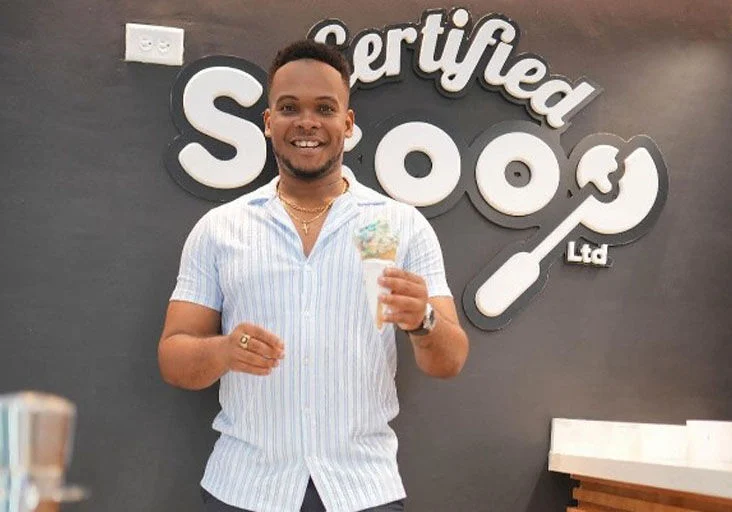
Few creators embody the content-to-commerce arc better than Jamel “Certified Sampson” Sampson.
What started as hilarious Trini skits on TikTok and Instagram evolved into a brand of belonging. Sampson used his comedic persona and relatability to build immense digital trust — and then parlayed that into Certified Scoops, a physical ice cream shop that feels like stepping inside one of his videos.
Bright colors, street-wise humor, and the local slang that made him famous online all come alive in-store. It’s not just ice cream — it’s Certified energy you can taste.
The model is scaling quickly: new branches have opened in Trincity and beyond (Newsday, 2025), with plans for regional expansion across the Caribbean (Guardian, 2025).
This is the blueprint for how local storytelling can evolve into a retail experience — a Caribbean MrBeast Burger moment.
2. Kyle Boss — 5AM Coffee Club
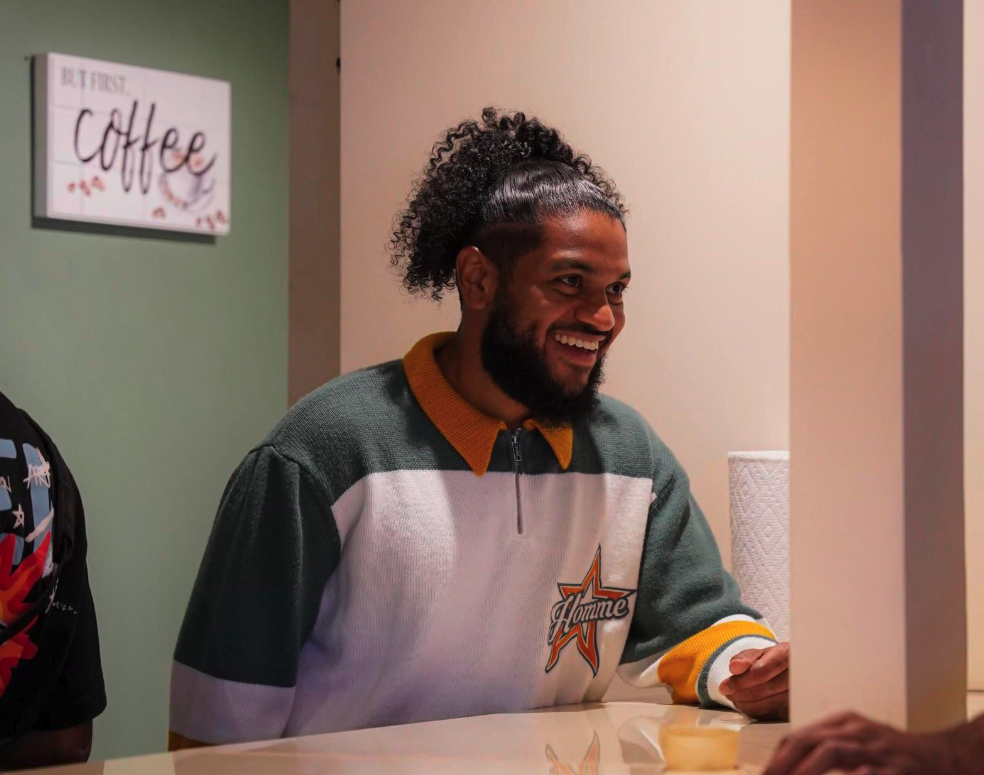
Where most see caffeine, Kyle Boss saw culture.
What began as motivational content and early-morning reflections online has transformed into the 5AM Coffee Club — one of the most recognizable creator-founded lifestyle brands in Trinidad.
The café isn’t just about coffee; it’s a philosophy of discipline and creative grind. The minimalist design, curated playlists, and “builders-only” energy have made it a sanctuary for entrepreneurs, content creators, and early risers.
Its second branch now sits on Ariapita Avenue — one of Port of Spain’s most vibrant cultural strips — proof that when community and culture merge, commerce follows.
This is how a personal brand evolves into a ritual movement.
3. Gervail Jr Lee — Comedy Fete
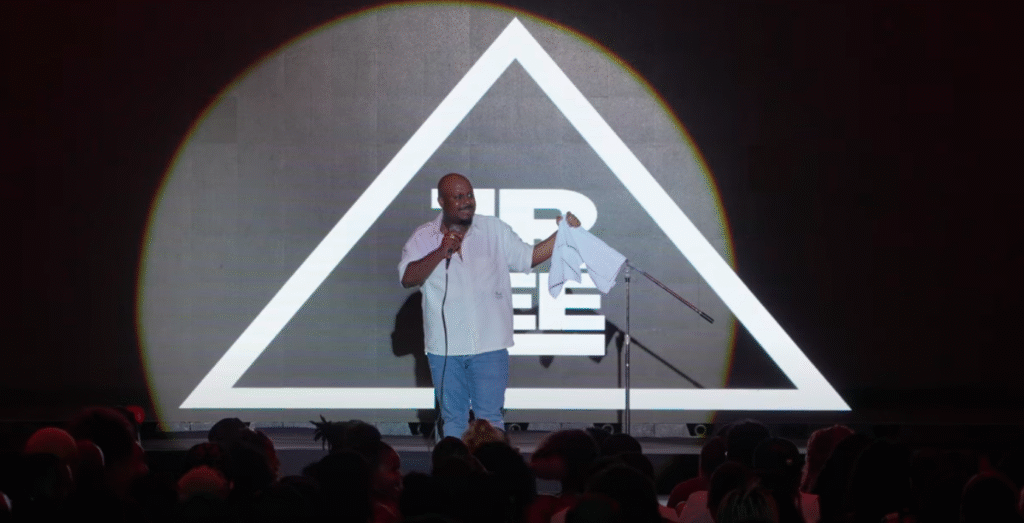
From viral sketches to international stages, Gervail “Jr Lee” Lee has turned his humor into an exportable experience.
Through his Comedy Fete series, he blends music, party culture, and stand-up into a format that feels distinctly Caribbean — a hybrid of Carnival energy and late-night comedy.
What makes it powerful is the participation loop: fans who discovered him online now show up offline, forming a living extension of the digital community. His tours across Canada and the Caribbean are proof that laughter is one of Trinidad’s most scalable exports (Guardian, 2025).
Comedy Fete isn’t just entertainment — it’s Trinidadian joy, franchised.
4. Renee Andrews — Sorvete
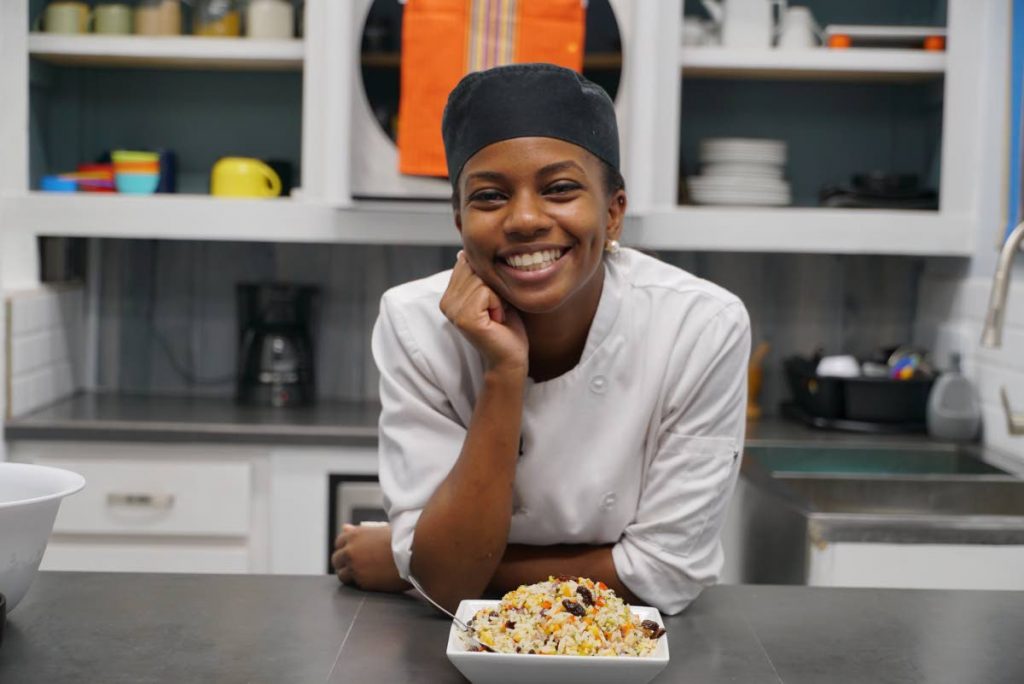
In a digital landscape dominated by filters and fast trends, Renee Andrews built something timeless: a visual and sensory brand experience.
Her business, Sorvete, began as a small-batch frozen dessert line, promoted through high-quality social content and behind-the-scenes storytelling. Her audience connected not just with the product, but with her process — the aesthetic of creation, craftsmanship, and indulgence.
With over 63,000 Instagram followers and 85,000+ on TikTok, Renee has proven that narrative and design can build a brand long before a physical space opens.
Her next move — Café Sorvete — will be the ultimate phygital leap: turning her online flavor fantasy into a physical dessert café that mirrors her brand’s elegant, minimal style.
The flavor sells the taste. The aesthetic sells the feeling.
5. Shaun Alexander — Foodie Nation / Island Spirit Pimento Sauce
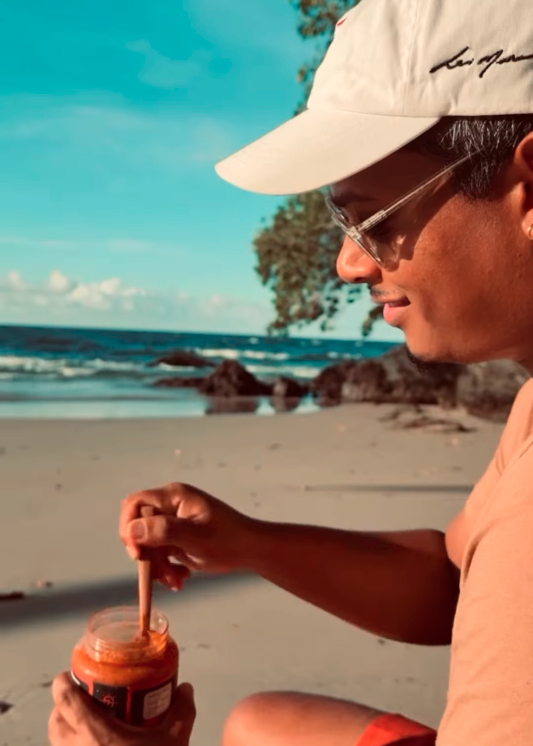
For nearly a decade, Shaun Alexander, co-founder of Foodie Nation, has been shaping how Caribbean audiences experience food online. His videos mix storytelling, history, and flavor — transforming everyday dishes into cultural artifacts.
In 2025, he translated that credibility into Island Spirit, a limited-release fermented pimento sauce created for food lovers who grew up watching his content.
The move feels inevitable: he spent years building trust around taste, and now he’s bottled it. His audience didn’t just buy a condiment — they bought into a legacy of Caribbean flavor.
This is the essence of community-led commerce — a product born from trust, not advertising.
6. FoodieTalesWithZaak — Food Tours
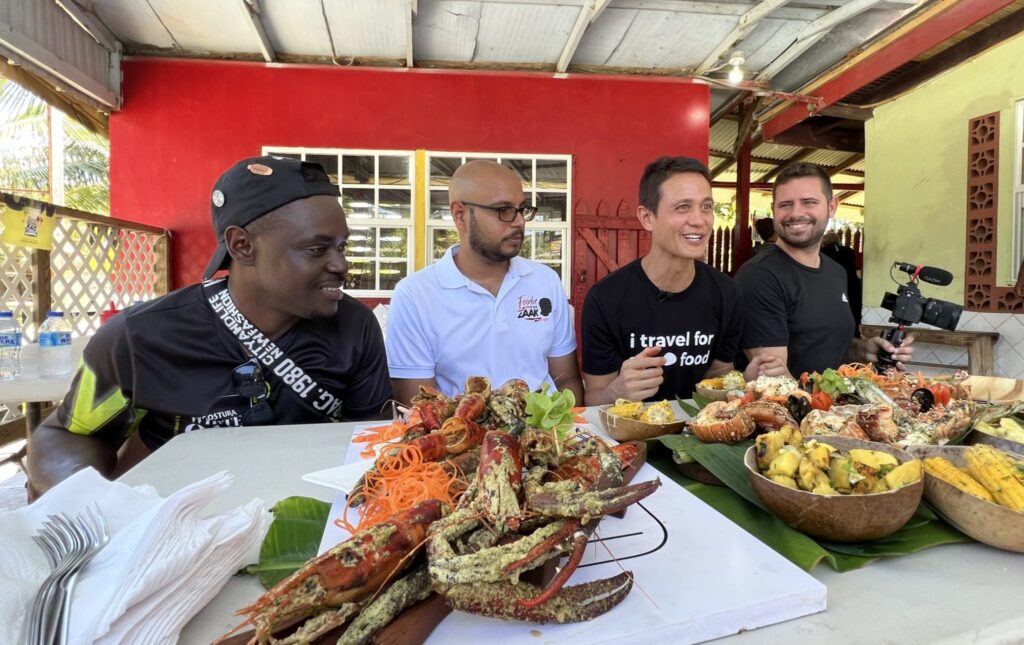
Foodie Tales with Zaak – Toco Tour with Mark Wiens in Trinidad and Tobago
Finally, Zaak’s FoodieTales represents the Experience Economy in purest form.
His “Taste of Toco Tour” takes fans from screens to seaside, curating culinary adventures that mix education, culture, and escapism. Guests sample local chow, homemade sweets, and roasted fish while engaging with vendors and storytellers who make Trinidad’s food culture so unique (VisitTrinidad.tt, 2025).
It’s a textbook application of Pine & Gilmore’s high-immersion “Escapist + Educational” realms — where customers don’t just consume; they participate.
Every stop, every story, every taste becomes a memory.
Together, These Pioneers Prove a Larger Truth
Digital trust can become physical transformation.
These six creators are doing what the global giants are doing — but they’re doing it Caribbean-style.
Their ventures are rooted in culture, community, and identity — the very elements that make this region magnetic.
They prove that the Caribbean isn’t behind the curve — it’s building its own version of the creator economy, one that fuses authenticity, storytelling, and experience.
And perhaps most importantly:
they’re showing that the next great Caribbean export won’t just be music, rum, or Carnival —
it will be experiences born from the digital heart of our culture.
VI. The Caribbean Challenge: Scaling the Movement
We’ve proven the creativity is there.
The innovation is there.
The audiences are there.
But to turn this creator wave into a creator economy — one that actually moves the GDP needle — we need more than hustle and Wi-Fi.
We need capital, infrastructure, and policy that match the ambition.
1. The Funding Gap: “Scared Capital” Is Stunting Growth
Here’s the hard truth: the Caribbean doesn’t have a money problem — it has a courage problem.
Venture capital exists globally in record numbers, but very little of it flows into creative or digital ventures in our region.
In 2023, the entire Caribbean attracted less than US $215 million in tech investment, compared to US $4 billion in Latin America and billions more in small countries like Estonia or Uruguay (Medium, 2025).
Local investors tend to favor “safe” sectors — banking, energy, or real estate — rather than scalable creator or digital businesses.
That’s what economists call scared capital: money that’s afraid of innovation.
But creator-led ventures — like Certified Scoops or Sorvete — are not side hustles. They are exportable cultural assets capable of earning global revenue if given the resources to scale.
What we need are regional creator investment funds that do three things:
- Back proven digital creators transitioning into physical businesses.
- Provide grants or seed capital for new Phygital ventures.
- Encourage corporate brands to co-invest in local creators the way Nothing partnered with MrWhoseTheBoss.
2. The Infrastructure Gaps: Building the Digital Roads
Even the best ideas can’t move forward without the digital “roads” to carry them.
Across much of the Caribbean, connectivity is fragile, e-commerce tools are underdeveloped, and logistics are slow.
Think about it — if a local creator wants to ship products abroad, collect online payments easily, or livestream events without glitching, they’re often forced to rely on foreign infrastructure.
That dependence has a cost: it drains value away from local economies and exposes us to what experts call digital colonialism — where Big Tech extracts data and profit, while regional creators get the crumbs (Strand Consult, 2025).
To fix this, we need to invest in Critical Internet Infrastructure (CII) — our own robust networks, payment systems, and digital marketplaces.
That’s how we secure digital sovereignty: when Caribbean creators can operate globally without their value leaking overseas.
3. The Policy Opportunity: Treat Creators as Exporters, Not Entertainers
Most Caribbean governments still see creators as “influencers” — entertainers who make content for fun or exposure.
But what’s happening now is economic.
Creator-led businesses are micro-exporters of culture, experience, and digital goods.
When someone books a FoodieTales tour, buys Sorvete’s desserts, or watches a Trini comedy clip from Canada — money and cultural influence are crossing borders.
It’s time to treat creators the way we treat manufacturing, tourism, or oil — as formal sectors worthy of policy incentives.
Governments can:
- Offer tax breaks or low-interest loans for creators opening physical spaces (e.g., cafés, studios, experience hubs).
- Fund training programs in e-commerce, storytelling, and experience design.
- Integrate creators into export development agendas, under “orange economy” or “creative industry” programs.
4. The Investments That Will Move the Needle
To build a thriving Caribbean creator economy, we need a few targeted, practical investments:
- Creator Venture Funds:
Pool public and private money to back creators with data-proven audiences and business models. - Phygital Incentives:
Offer grants or tax deductions for creators who convert online influence into physical ventures — like a Sorvete Café or a 5AM Coffee expansion. - Critical Internet Infrastructure:
Strengthen local cloud, broadband, and payment rails so creators can sell globally and keep profits local. - Experience-Focused Entrepreneurship Training:
Teach creators how to build experiences — not just content — by combining storytelling, design, and digital tools.
The Big Picture
The Caribbean doesn’t have a creativity problem. It has an ecosystem problem.
Our creators have already proven they can capture attention, build communities, and generate sales.
The next step is making sure they can scale — sustainably, regionally, and globally.
Because if we get this right, the Caribbean’s next big export won’t come from oilfields or factories.
It’ll come from the creators who learned how to turn culture into an experience — and experience into an economy.
VII. The Future: Experience as the New Competitive Edge
The global marketplace is entering a new era — one where experience has become the ultimate differentiator.
Attention can be bought. Followers can be faked. But experience — that can’t be replicated.
Brands and creators who understand this are rewriting the rules of business.
From Attention to Immersion
We’re moving through a clear progression in digital entrepreneurship:
Attention → Community → Commerce → Experience.
In the early creator economy, success was about capturing attention.
Then came community — nurturing loyal audiences who trusted your voice.
Next, we learned how to monetize that trust through commerce.
Now, the frontier is experience — where audiences don’t just consume your content, they live inside your brand world.
The brands and creators who thrive in this new phase are the ones designing every interaction — online and offline — to make people feel part of something.
Because in 2025 and beyond, reach matters less than resonance.
The new competitive advantage is immersion.
Why Experience Wins
Algorithms can change overnight. Viral moments fade in hours.
But experiences linger — they build emotional capital that no ad spend can buy.
When people walk into a Sorvete Café, visit Certified Scoops, or join a FoodieTales tour, they’re not just interacting with a business — they’re participating in a story.
That story is what keeps them coming back, telling friends, and sharing online.
This is the power of experience as strategy:
It multiplies your marketing because your customers become your storytellers.
The Caribbean’s Advantage
If experience is the new global currency, the Caribbean already has a head start.
Our culture is built on energy, storytelling, and sensory richness — we’ve always known how to make people feel.
Carnival is an experience. A doubles lime is an experience. A beach cookout, a sunrise run, a backyard jam — all of these are emotional economies.
What’s changing now is that digital tools allow us to monetize them intentionally.
The same skills that make us world-class storytellers, entertainers, and hosts are the ones now powering this creator-led transformation.
We’re not just catching up to the global creator economy — we’re redefining it through culture.
The Big Insight
The next evolution of entrepreneurship isn’t about how many people you reach — it’s about how deeply you can make them belong.
That’s what the global economy is rewarding now.
The Caribbean’s superpower — our ability to create feeling and community — is exactly what the future of business is built on.
VIII. The Ecosystem Vision: Building the Caribbean Experience Economy
We’ve seen what’s possible — creators transforming influence into innovation, audiences into communities, and stories into sustainable businesses.
But for this movement to grow beyond isolated success stories, it needs a system — an ecosystem that connects creativity with capital, technology, and policy.
The future of Caribbean growth depends on one big shift:
we must start treating creators as infrastructure — not entertainment.
1. For Policymakers: Make Creativity a National Investment Strategy
Creators aren’t hobbyists — they’re economic actors driving exports, innovation, and youth employment.
Every skit, tour, café, or pop-up rooted in Caribbean culture is a micro-export — spreading our identity and generating foreign income.
Governments must start:
- Building creator economy programs under trade and investment ministries.
- Allocating funding for creative incubators, digital storytelling training, and creator grants.
- Incentivizing Phygital expansion — giving tax breaks or low-interest loans to creators turning online influence into physical experiences like cafés, studios, or event venues.
- Developing Critical Internet Infrastructure (CII) — so Caribbean creators can operate globally, sell digitally, and keep the value at home.
If tourism can be a national pillar, so can the creator economy — because both are built on the same foundation: experience.
2. For Investors: Fund Stories, Not Just Startups
Traditional investors are missing a trillion-dollar opportunity hiding in plain sight.
The creator economy is projected to reach $480 billion by 2027 (Goldman Sachs, 2023) — yet the Caribbean received less than US $215 million in total tech investment in 2023.
That’s not a funding gap — that’s a vision gap.
Creators already have:
- Built-in audiences
- Proof of demand
- Authentic cultural relevance
What they lack is growth capital.
The solution?
- Establish Creator Venture Funds focused on Caribbean D2C and Phygital ventures.
- Encourage public-private partnerships between corporate brands and local creators, mirroring collaborations like Nothing × MrWhoseTheBoss.
- Fund creators who demonstrate conversion metrics — not just followers — and back those ready to expand regionally or globally.
Investors must realize: the next Glossier or MrBeast Burger could just as easily come from Kingston, Port of Spain, or Bridgetown.
3. For Creators: Think Beyond Content — Design Worlds
This new economy rewards experience builders, not just content makers.
If you’ve built an audience, you’ve already done the hardest part — you’ve earned trust.
Now, the question becomes: What can people experience through you?
Whether that’s:
- A boutique brand they can taste or touch,
- An event or tour they can join,
- A lifestyle or identity they can participate in —
The opportunity lies in translating your story into immersive formats people can live.
Don’t wait for sponsors.
You are the brand.
And in this era, creators who merge storytelling, technology, and culture will lead the Caribbean’s next economic leap.
4. The Shared Mission: A Connected, Creative Caribbean
If we get this right — if creators, investors, and governments align — the Caribbean won’t just consume the digital future.
We’ll define it.
Imagine regional hubs where creators collaborate across islands.
Imagine governments offering export incentives for digital content.
Imagine investors funding cafés, studios, and tours that merge culture and technology.
That’s the Caribbean Experience Economy — where creativity becomes commerce and stories become strategy.
“The next wave of Caribbean entrepreneurship won’t be built in offices or malls — it’ll be built in experiences. Those who can turn content into belonging will own the future.”
Ready to Turn Your Digital Influence into Income?
Digital monetization is evolving fast — and creators who understand how to build multiple income streams will shape the future of online business.
If you’re ready to move beyond guesswork and create a clear, profitable plan for 2026, join me for the Digital Revenue Roadmap Workshop. We’ll help you identify the best monetization opportunities for your brand, the tools and systems you need, and guide you through building your personalized roadmap to sustainable digital income.
📅 Saturday, Oct 18th or Sunday, Oct 19th
💰 $45 USD / $300 TTD
🎥 Includes 30-day replay + lifetime course access
👉 Learn more and register here:
The Digital Revenue Roadmap Workshop
